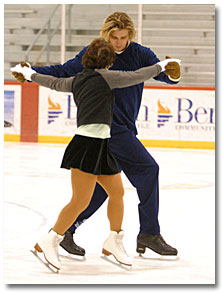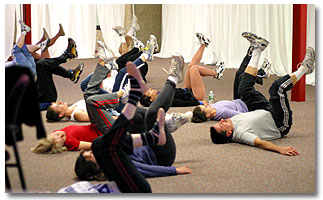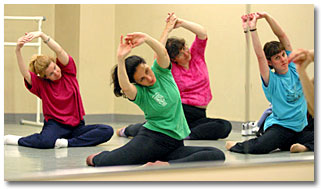Michelle Wojdyla
Check out photos from U.S. Figure Skating’s Adult Training Camp
Adult skaters were thrilled to work with Peter Tchernyshev at the camp.

For the second straight year the Ice House in Hackensack, N.J., hosted the U.S. Figure Skating Adult Training Camp. Eighty-five skaters took part in the two-day on- and off-ice classes June 28-29. They were coached by some of the top names in figure skating, including Tamara Moskvina and Igor Moskvin. New to this year’s camp were Artur Dmitriev, John Zimmerman and Silvia Fontana teaching the freestyle track. After Liz Coates was forced to cancel due to injury, reigning U.S. ice dancing champion Peter Tchernyshev signed on as the dance coach. Ice House staff Neil Ruben and Edward van Campen returned for spins and moves in the field, respectively, and Tatiana Droutchinina led stretching classes.
The seven freestyle groups were broken down by test level and all the ice dancers comprised the eighth group. With approximately 10 skaters per group, this allowed
for more individual attention by the coaches — something the returning skaters
vocally praised.
“I felt like I was being coached by skating’s royalty,” commented one attendee.
On Saturday the freestyle skaters had three on-ice sessions: toe jumps with Moskvina and Moskvin, edge jumps with Fontana and Zimmerman, and spins with Dmitriev and Ruben. All skaters had an off-ice session in stretching with Droutchinina, and strength/conditioning with fitness instructor/physical therapist Vince Burke. The dancers had moves in the field with van Campen as well as three on-ice sessions with Tchernyshev, who was joined by Naomi Lang for some of the classes. Everyone ended the day with a power stroking class.
The strength and conditioning class, taught by Vince Burke, practiced exercises that strengthen the core as well as improve balance.

Group 7 (the most advanced freestyle skaters) and the dancers were challenged in their power stroking class by Zimmerman and Tchernyshev. Tchernyshev would come up with a move, and then he and Zimmerman would demonstrate by racing each other across the length of the ice before turning it over to the students. This particular session was the buzz of the day as Tchernyshev made it a point to challenge everyone, including Zimmerman.
“We were just trying to feed off each other,” Tchernyshev said. “We were showing off executing as a pairs skater and a dance skater. I tried to think of the simplest exercises that I could come up with so all the different levels would feel comfortable with it, and yet at the same time without thinking of the technical aspect of the exercise; [just] trying to work on their power and speed. [I also did] a couple of unusual exercises, like some you would never do or consider skating, like running on the skates. We had fun. Everybody was laughing.”
Adult skaters work in the stretching class taught by Tatiana Droutchinina.
“There was some serious eye candy in that class,” said one skater who asked to remain anonymous. “That alone was worth the price
of the camp!”

Tatiana Droutchinina.
On a more serious note, one of the challenges that faced the skaters was hearing a new way of approaching an element. Faye Greel, a silver-level skater, appreciated the approach Dmitriev took when challenged by one of the skaters in spin class.
“One man said, ‘You mean I have spent all this money learning to do it this way and now you want me to do it this other way?’ (Artur) was very good. He said, ‘I show you why,’ and brought him over to the side. (Artur) said, ‘Try my way. I’m just asking you to try it to see if it’s easier.’ I think a lot of adults were caught up in a ‘right or wrong way,’ and it was really opening their eyes to different ways.”
“That’s sometimes one of the biggest things about camps is that we’ll say the same thing a lot of coaches say, but we’ll just say it differently,” Zimmerman said. “Some of the skaters have done things for the first time with us, and that’s of course the most rewarding thing, but that comes from hearing sometimes the same thing they hear from their coach coming from a different person or worded differently.”
During one of the lunch breaks on Saturday, cheers and shouts were heard coming from Rink 3, where Zimmerman and Fontana were working on edge jumps. Everyone looked up to find out what was going on, and one of the skaters came running into the cafeteria area to announce that someone had just landed a Salchow for the first time. This brought more cheers.
“When you follow [the coaches] when they’re doing something, you just snap right into that,” Greel said. “You try to be a better skater because you go with the flow [and] their technique. You realize you’re doing part of it — it might not be the whole thing — but it’s enough to make you better. You get better just like that by following them.”
John Zimmerman (left) and Peter Tchernyshev have their own race in a power stroking class.
On Sunday, all skaters attended an injury prevention lecture by Dr. Rick Braver. The freestyle skaters had on-ice sessions in combination jumps taught by Moskvin and Dmitriev, body movement with Moskvina and Fontana, and van Campen’s moves in the field class. They also had off-ice jumps with Zimmerman. The dancers had an off-ice question-and-answer session with Tchernyshev as well as three on-ice sessions. Tchernyshev said he tried to use the Sunday sessions to build on what he taught the skaters the previous day.
“I asked Naomi (Lang) to help me a lot with the partnering aspects of
ice dancing,” Tchernyshev said before the second day of camp. “Today (Sunday) we are going to do some lifts and spins. Yesterday I tried to give guidelines [to the skaters] — general information and exercises.
At the end of the day [I took] written requests from each skater — what they would want to work specifically on — so [I will try] to satisfy
those suggestions.
“One request was different interpretations of music. [Showing] simple stroking and cross rolls, I tried to give the idea of the varying different rhythms, like blues, waltz, cha-cha,” Tchernyshev continued. “It’s very hard to combine the dance moves you are capable of doing when you’re [not skating]. Once you start moving it’s hard to maintain the same amplitude, the same dynamics. It takes lots of practice to do that.”
Pre-silver dancer Jennifer Lagomarsino made a last-minute decision to come to the camp.
“We worked on a lot of technique, like stroking technique, and a lot of edge work that’s been very beneficial,” she said. “The moves in the field class was excellent. I have issues with my hips, so it was good positioning-wise. Peter is very good at putting you where you need to be. That’s been very helpful to learn some body awareness that you take for granted a lot of times. I think for me, that’s been the biggest thing.”
One of Sunday’s classes that seemed to elicit the most laughter — but also the most sweat — was Zimmerman’s off-ice jumping. Using personal anecdotes to help illustrate the advantages (and risks) of off-ice jumping, Zimmerman had his groups learn some important lessons like, “Make sure you don’t practice double toe loops in a bedroom too close to the furniture or you could break your toe,” like his mother did.
“[Off-ice jumping is] fun because you’re not on skates and everyone feels comfortable in shoes on the ground,” Zimmerman said. “When you’ve got those skates on, it’s kind of like you’ve got your game face on and all of a sudden everyone is [thinking] ‘I’ve got to do this.’ When they’re relaxed and in their own element, I think they are sometimes more receptive. It’s not life-threatening to go out there and throw yourself into an Axel. You can concentrate on smaller things.”
Tasney Mazzarino, a gold-level skater, admitted she was concerned that everyone would be trying to get autographs from the coaches or would be too much in awe of them.
“I think it’s a hundred times more worth it to be on the same ice with them,” she said. “[We can] appreciate the level of skating and the training that they’ve gotten. There are so many different techniques, and [we’re] getting to see different styles and then taking from it what we can use for ourselves — that’s more important than an autograph.”
Nevertheless, at the end of the camp, time was allotted for autographs, photos, and a group question-and-answer session. The skaters picked up their certificates of completion and many had them signed by the coaches.
“It should say ‘has successfully survived,’ joked a couple of sore freestyle skaters, who were just as anxious as the others to attend the next U.S. Figure Skating Adult Training Camp.

